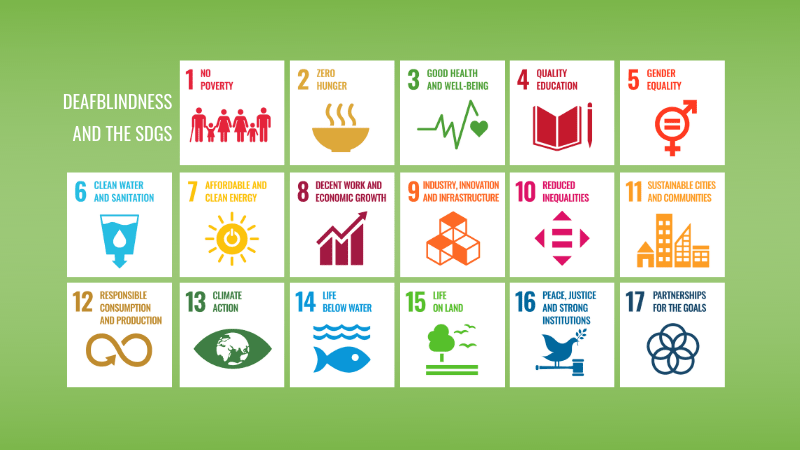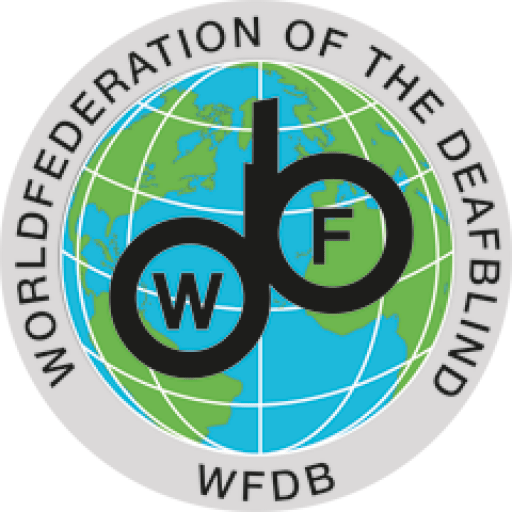
The 2030 Agenda for Sustainable Development with its 17 Sustainable Development Goals (SDGs) is an ambitious plan for crafting a better, more inclusive, and sustainable world, promising to leave no one behind. Preceding the Millennium Development Goals (MDGs) (2000-2015), the SDGs were adopted by United Nations Member States in 2015 as a call for action to promote a prosperous and sustainable future for all.
The High-Level Political Forum on Sustainable Development (HLPF) 2022 meeting is fast approaching and will take place from 5 to 15 July. At the HLPF 2021 meeting, the following SDGs were discussed, amongst others: SDG1 – No poverty, SDG3 Good health and well-being, SDG10 – Reduced inequalities. This year’s HLPF meeting will focus, amongst others, on SDG4 – Quality education and SDG5 – Gender equality.
Whilst excitedly waiting for the outcome of the HLPF 2022, we have had a look at what the literature and data say about the situation of persons with deafblindness in the context of the SDGs. With eight years left before the SDGs are to be achieved, where do persons with deafblindness stand with regards to the implementation of the SDGs?
SDG 1 – NO POVERTY
Persons with deafblindness are more likely to be poor compared to both persons with other disabilities and persons with no disabilities (1). Data also suggests that persons of working age with deafblindness may be more greatly affected by poverty, as poverty is more common in households with younger members with deafblindness (1).
“In low and middle-income countries, as well as some high-income nations, social protection benefit schemes tend to focus on basic poverty-related issues and do not cover the extra costs related to interpretation or mobility challenges. As a result of limited service provision and low social benefits, persons with deafblindness cannot afford the support they need.” (1)
SDG 1 Targets still to be achieved:
WFDB Recommendations:
- Disability determination and eligibility processes should consider persons with deafblindness as a distinct disability group (1)
- Disability schemes should take into consideration the significant extra cost of deafblindness, including assistive technology, personal assistance and interpreter-guide services (1)
SDG 3 – GOOD HEALTH AND WELL-BEING
Between 20-75% of persons with deafblindness have additional disabilities (1). Research have also found that persons with deafblindness are more likely to experience depression and other mental health issues when compared to people without sensory impairments or with visual or hearing impairments alone (1).
“In emergency situations, health providers often have no idea how to communicate with a person with deafblindness. This means that the experience can be extremely frightening and/or violating for the person, who does not know what is happening.” (1)
SDG 3 targets still not achieved:
WFDB Recommendations:
- Provide adequate training to healthcare staff both on the causes of deafblindness and the specific communication requirements of persons with deafblindness (1)
- Ensure access to adequate sexual and reproductive health services, with an emphasis on women and girls with deafblindness (1)
- Ensure the provision of adequate early detection and intervention services, in partnership with education providers (1)
- Ensure the adequate provision of interpreter-guides (1)
SDG 4 – QUALITY EDUCATION
Children with deafblindness are up to 23 times less likely to be in school than children without disabilities (1). Similarly, adults with deafblindness are less likely to have ever been in school than adults with other disabilities and adults with no disabilities (1).
“In many countries, a lack of awareness about deafblindness results in both families and institutions failing to recognise the right of children with deafblindness to go to school, and that education obligations apply to all children, regardless of their disability.” (1)
SDG 4 targets still not achieved:
WFDB Recommendations:
- Ensure that the requirements of persons with deafblindness are taken into account in inclusive education laws, policies and programmes, and efforts are made to adapt curricula, train teachers and provide support to students (1)
- Ensure the availability of resource centres that support mainstream schools, children with deafblindness and their families (1)
- Ensure the adequate provision of interpreter-guides (1)
SDG 5 – GENDER EQUALITY
Women with deafblindness are less likely to be married than men with disabilities (1). Women with deafblindness are also more likely to be exposed to gender-based violence and unwanted pregnancies (1).
“Due to gender-based discrimination, each of these [barriers are] magnified for women with deafblindness, who are more exposed to abuse and sexual violence.” (1)
SDG 5 targets still to be achieved:
SDG5.1 End all forms of discrimination against all women and girls everywhere
WFDB Recommendation:
- Ensure access to adequate sexual and reproductive health services, with an emphasis on women and girls with deafblindness (1)
SDG 8 – DECENT WORK AND ECONOMIC GROWTH
Persons with deafblindness are less likely to be working than persons with other disabilities and persons with no disabilities (1). A study carried out by Sense International in Peru in 2018 found that the main barrier faced by persons with deafblindness when seeking employment, was the prejudice of employers and co-workers (1).
“A lack of recognition of deafblindness as a unique disability […] [l]eads to people being excluded from legislation in many countries, such as Bolivia, where employment law does not mention persons with deafblindness. Often persons with deafblindness are not included in vocational training and employment programmes for other persons with deafblindness.” (1)
SDG 8 targets still not achieved:
WFDB Recommendations:
- Ensure that persons with deafblindness are adequately included in employment-related laws, policies and programmes (1)
- Ensure adequate provision of interpreter-guides for work and employment (1)
SDG 9 – INDUSTRY, INNOVATION AND INFRASTRUCTURE
Assistive devices that allow access to digital communication for persons with deafblindness are expensive and often out of reach for persons with deafblindness, who are statistically more likely to live in poverty (1).
“One of the key issues is that policymakers do not view support services and assistive technology as a ‘fundamental need’, and consider them luxuries in comparison to shelter and food. However, these services are essential for daily living, especially for persons with deafblindness who have high support needs.” (1)
SDG 9 target still not achieved:
WFDB Recommendation:
- Disability schemes should take into consideration the significant extra cost of deafblindness, including assistive technology, personal assistance and interpreter-guide services (1)
SDG 10 – REDUCED INEQUALITIES
Lack of information about political parties and programmes, inaccessible political debates and even inaccessible voting ballots make voting difficult for persons with deafblindness (1). There is also a lack of persons with deafblindness being represented in politics at all levels (1).
“Persons with deafblindness have access to limited political information. Many often do not even know the names of the political parties or what they stand for. In turn, this reinforces existing prejudices among some families that persons with deafblindness are unable to vote.” (1)
SDG 10 targets still to be achieved:
WFDB Recommendations:
- Ensure that the right to vote is granted to all persons with deafblindness (1)
- Take into consideration the accessibility requirements of persons with deafblindness with regards to election campaigns, voting materials and polling stations (1)
- Support the engagement of persons with deafblindness in political and public life (1)
- Support organisations of persons with deafblindness and involve them as a distinct disability group in all consultations with disability movements (1)
Other SDGs:
Other SDGs e.g., SDG6 (Clean Water and Sanitation), SDG7 (Affordable and Clean Energy), and SGD13 (Climate Action) are also important to achieve in order to secure the human rights of persons with deafblindness. Climate change has a known impact on marginalised groups such as persons with disabilities (2). Although there is little data on the situation of persons with deafblindness, one can assume that environmental factors affecting other disability groups also will have a great impact on persons with deafblindness.
Want to learn more?
Learn more about the SDGs at United Nations’ Sustainable Development Goals website
Learn more about the situation of persons with deafblindness by reading the Initial global report on situation and rights of persons with deafblindness
Sources:
- Jensen, R. et al (2018): At risk of exclusion from CRPD and SDGs implementation: Inequality and Persons with deafblindness. Initial global report on situation and rights of persons with deafblindness. Available at: https://www.wfdb.eu/wp-content/uploads/2019/06/WFDB_complete_Final.pdf?_gl=1*1mkagcr*_ga*MTE2OTI4NjA3NC4xNjQ3ODUxNTU3*_ga_NRL61RGTBM*MTY1MTQ5MjE4MC4yNS4xLjE2NTE0OTIyMTUuMA..&_ga=2.20759153.854726364.1651492193-1169286074.1647851557
- Human Rights Council (2022): Analytical study on the promotion and protection of the rights of persons with disabilities in the context of climate change. Report of the Office of the United Nations High Commissioner for Human Rights. Available at: https://documents-dds-ny.un.org/doc/UNDOC/GEN/G20/097/56/PDF/G2009756.pdf?OpenElement
